Shoulder mobility is important for swimmers to develop and is an integral part of a swimming specific yoga practice. If you have tight shoulders it can limit range of motion, which can have a negative effect on performance and leave you vulnerable to injury
The short swimming specific yoga class above goes through several poses to help develop shoulder mobility.
Remember when working on shoulder mobility ensure that is your first priority is stability. Without stability creating greater range of motion will not help you in the water and can lead to injury.
In this swimming specific yoga class we focus on stability by creating body awareness as well as scapular control.
This swimming specific yoga class uses several of the poses below.
Intentional Shoulder Rolls
Cues:
- Start in mountain pose
- On an inhale move the shoulder blades up the back
- On an exhale bring the shoulder blades towards the spine
- On an inhale move the shoulder blades down the back
- On an exhale move the shoulder blades away from the spine pressing the shoulders forward
- On an inhale move the shoulder blades up the back
- End in mountain pose
Lunge with Thoracic Twist
Cues:
- Come into a lunge with your left foot forward and your right foot back
- Have your knee directly over your ankle with your foot and knee pointed straight forward
- Stabilize and square your hips
- Bring the front hip back and the back hip forward
- Feel like
- You are dragging the feet towards each other without moving
- Your thighs are scissoring towards each other
- Keep your right palm down on the ground
- Keeping your hips as stable as possible bring your left arm up and out to the side
- Twisting through the thoracic spine
- Opening through the chest and shoulder
Lunge with Cactus Arms
Cues:
- Start in a lunge ensuring that:
- The hips are square
- The core is engaged
- There is active length in the spine
- On an exhale bring your arms to cactus
- 90° at your shoulders 90° at your elbows
- Keep the spine long and core strong
- Draw the arms back and the shoulder blades towards the spine opening up through the chest and shoulders
Cat Cow
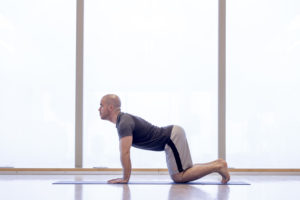
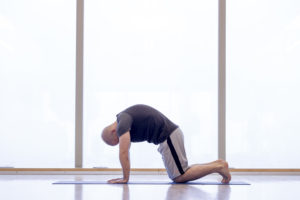
Cues:
- Begin in table top
- On an inhale
- Lift your tailbone
- Arch your spine
- Bring your chest forward and look forward
- Draw your shoulder blades towards your spine
- On an exhale
- Drop your tailbone
- Round your spine
- Drop your head
- Press the ground away feeling the shoulder blades come away from the spine
Child’s Pose
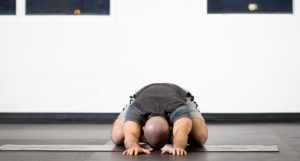
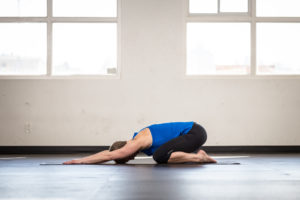
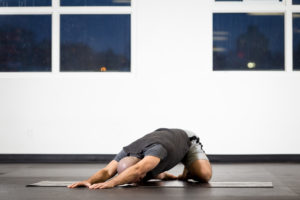
Cues:
- Start on your knees with the top of the feet down
- Bring the big toes together
- The knees can be wide or together
- Fold forward at your hips and bring your seat towards your heels
- Place the head on the ground and reach forward with the finger tips
- Once at full extension press the finger tips into the ground and feel as if you are pulling the mat back towards your armpits
Side Stretch Variation
Cues:
- From child’s pose on an inhale start to reach your hands and upper body to the right
- As you do this lift your belly up and place it on your towards your left thigh
- Feel as if the right side of your seat is dropping down towards your heel
Locust (Varations)



Cues:
- Start on your stomach with your arms by the side and palms on the ground
- Press the top of the feet into the ground
- Hover the nose just off the ground keeping the neck long
- On an inhale draw your shoulder blades towards the spine and lift your palms off of the ground reaching your fingers tips towards the heels
- Option – turn the palms to face each other
- Allow the movement of the shoulders blades to lift the chest and bring the front of the shoulders away from the ground
Ys and Is
- On an inhale bring your arms out to the side and move them slowly until you are reaching overhead
- You can first stop where the arms come to the shape of a Y
- Continue to where the arms are straight from the shoulders into the shape of an I
- Pause and slowly with the strength in the back of the shoulders brings the palms higher off the ground
- Option – you can raise and lower the hands a few times following your breath
Ws
- On an exhale bring your elbows in towards the spine with the finger tips pointing forward
- As you create the shape of a W focus on bring the shoulder blades towards the spine
Puppy Dog (Variation)

Cues:
- Begin in table top pose
- Keep your hips over your knees
- Come down onto your elbows
- Place the palms together behind your head bringing your thumbs towards the spine
- Bring your head on or towards the ground keeping the elbows close to the ears
- Press the sternum towards the ground
- Press the elbows down and feel like you are dragging the mat back towards your hips
- If you need more intensity you can bring the knees back a few inches
Lying Chest Stretch
- Lie on your stomach with your right arm in cactus
- Shoulder and elbow at a 90° angle with the palm down
- Press your hand and forearm into the ground creating stability in the shoulder
- Place your right ear on the ground
- If that is uncomfortable you can place a blanket or cushion under your head
- Place your left palm down under your left shoulder
- On an exhale press into the ground with the left hand starting to roll yourself onto your right side
- To stabilize yourself you can bring your left foot flat on the ground in front of you with your knee pointed towards the sky
Reclined Shoulder Rotations


Cues:
- Starting flat on your back place the soles of the feet on the ground
- Feet can be:
- Mat distance with the hips internally rotated and knees resting upon each other
- Hip distance and knees hip distance
- Start in cactus with the arms – 90° at the shoulders 90° at the elbows
- On an inhale keeping the elbows on the ground internally rotate the shoulders bring the forearms and hands off of the ground and bringing the palms towards the ground (*they do not need to reach the ground)
- Keep the traps relaxed and do not force the range of motion
- On an exhale return to cactus
…
During the world’s fight against COVID-19 you can visit our website to develop your yoga for swimmers practice with several free classes ranging from 25-45 minutes. To access these classes click here.
…
This Yoga for Swimmers article is brought to you by Swimming Specific Yoga the world’s top resource for online yoga classes and content designed for swimmers and multi-sport athletes.
Sign up here to receive the Swimming Specific Yoga newsletter
The newsletter includes information on how yoga can enhance both your swimming performance and your wellness.
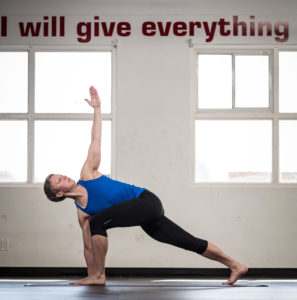



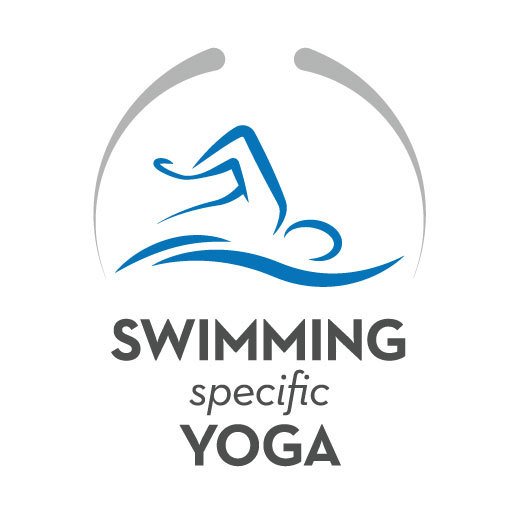
If any swimmers have even a mild case of scoliosis they need to be careful with a couple of these. The thoracic twist should be avoided, along with any other exercises that twist the spine. These will only speed up the degeneration and quicken the progression of scoliosis. However, poses like the cat are beneficial in slowing the progression of scoliosis and gives strength to the spine and core.
Bob excellent points. When it comes to any training individual differences and any vulnerabilities should be taken into consideration. The ones you point out about scoliosis are very good ones.
In my opinion, eagle arms (the last one) is actually bad for swimmers! I believe it creates shoulder joints that are too loose for swimming, and can very easily lead to shoulder problems. Proper shoulder stability is key to avoiding swimmers shoulder. More shoulder mobility is definitely not always better.
Coach DK you are absolutely right when you say that shoulder mobility is not always better.
A combination of stability and mobility is the key. It is all about balance. The key to every pose being effective and safe (including eagle arms) is that balance – never sacrificing stability to gain more range of motion, which I talk about in my previous article on the fundamentals of a yoga practice designed for swimmers.
Some people are hypermobile, which can be a problem and create instability. Others are very limited in their range of motion due to tightness, which can also be a problem.
Addressing one without the other can lead to vulnerability in the targeted joints. Both stability… Read more »